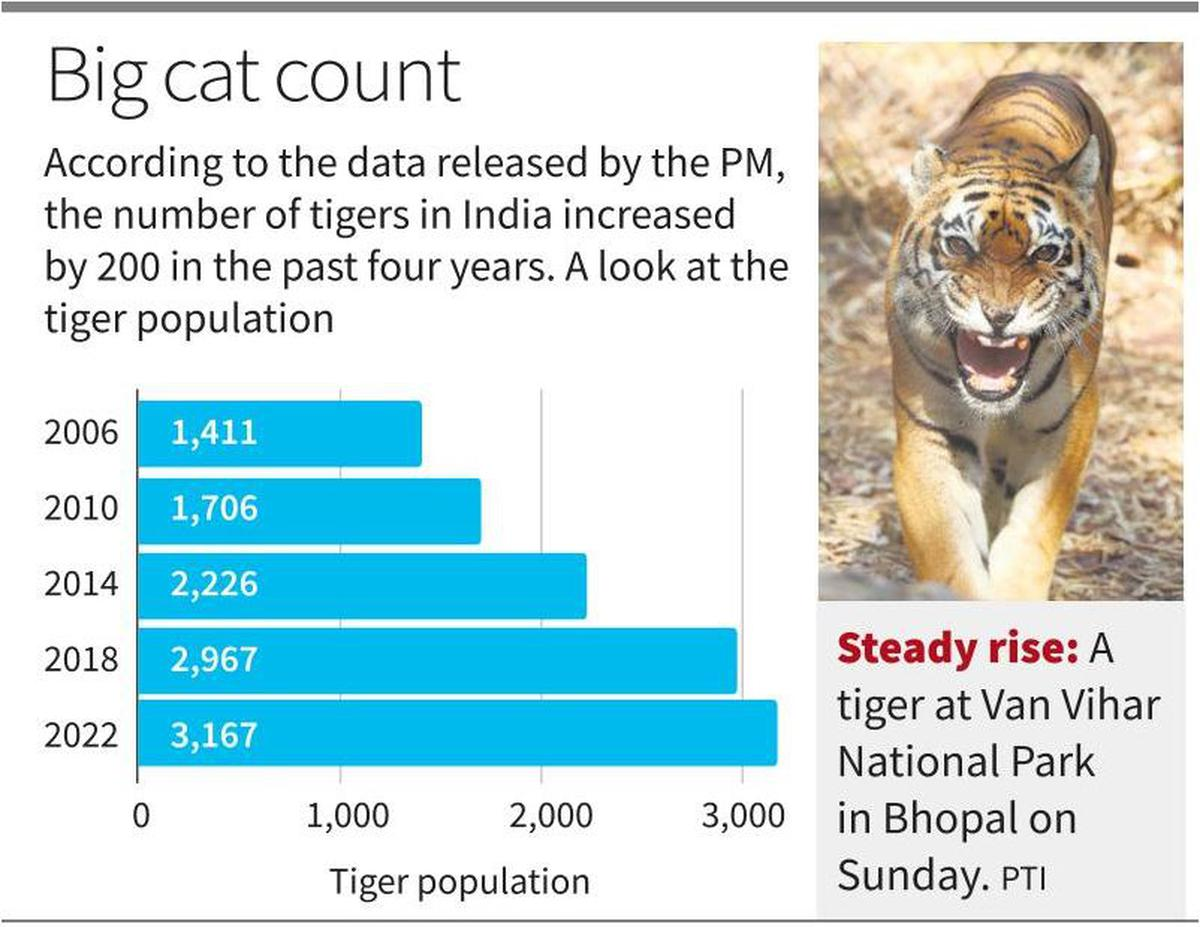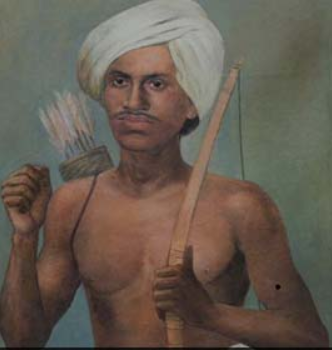Biodiversity & Environment
Global Tiger Numbers Rise, Southeast Asia Faces Habitat Threats
For Prelims: Tiger, Global Tiger Recovery Program (GTRP), United Nations Convention on International Trade in Endangered Species (CITES), International Tiger Day, World Bank, WWF, St. Petersburg Declaration, Tiger Range Countries (TRCs), International Tiger Forum, Global Tiger Initiative (GTI), Tiger Conservation Landscapes (TCL).
For Mains: Issues Countries facing in conservation of wildlife including tigers, Achievements of Project Tiger in India and related learnings, Human-Wildlife Conflict.
Why in News?
Countries have submitted tiger population numbers from 2010-2022 to the Global Tiger Recovery Program (GTRP) and United Nations Convention on International Trade in Endangered Species (CITES) under GTRP 2.0 which aims to pave the way for tiger conservation from 2023-2034.
- The St Petersburg Declaration in 2010 saw 13 tiger range countries commit to reversing the decline of the species population and double their numbers by 2022.
What is the Status of Tiger Conservation in World?
- The wild tiger status is good in South Asia and Russia, but the picture in Southeast Asia is grim, posing challenges to the global tiger population recovery.
- There has been an overall increase in the tiger population by 60%, taking the number to 5,870.
- However, countries like Bhutan, Myanmar, Cambodia, Lao-PDR and Vietnam showed a decline in tiger populations, making the situation “grim” in the Tiger Range Countries (TRCs) of Southeast Asia.
- The success of countries in South Asia like Bangladesh, Bhutan, India and Nepal including China and Russia in North East Asia is attributed to effective measures taken for habitat conservation and protection.
- India's wild tiger population is 3,167 in 2022. Nepal has tripled the tiger population.
What is Global Tiger Recovery Program 2.0 (2023-34)?
- Global Tiger Recovery Programme (GTRP) 2.0 was released at Thimphu on 29 July International Tiger Day 2023 by Minister of Foreign Affairs, Royal Govt of Bhutan.
- GTRP was launched by the World Bank in 2010 under the Global Tiger Initiative (GTI) to double wild tiger populations by 2022, with commitments from Tiger Range Countries (TRCs).
- The Global Tiger Forum (GTF) became the implementing arm for the tiger agenda.
- GTRP 2.0 has been firmed up by tiger range countries through the intergovernmental platform of the Global Tiger Forum along with collaborators like the Worldwide Fund for Nature (WWF).
- GTRP 2.0 emphasizes on strengthening tiger governance, enhancing resources and protection, while addressing contemporary challenges like Human-Wildlife Conflict.
- The new version has retained several ongoing archetypal actions along with new ones for a differentiated approach to save the endangered wild tigers.
What are Threads to the Tiger Population in the World?
- Prey and Tiger Poaching: The situation is said to be challenging in the region due to widespread prey and tiger poaching combined with other lacunae such as inadequate patrolling, poor wildlife monitoring, forest loss for commercial needs, proximity to wildlife trade hubs and rapid infrastructure development resulting in fragmentation.
- Low Investment in Wildlife Conservation: Poor monitoring and low investment in wildlife conservation are other reasons for the drop in tiger populations.
- Habitat Loss and Fragmentation: Habitat loss and fragmentation, along with depleting biodiversity due to anthropogenic reasons among others, is another concern raised threatening the tiger conservation.
- The report observed that loss of forest is a major factors across its ranges, with rapid decline in Southeast Asia.
- Degradation of Tiger Habitat: The tiger habitat has seen degradation due to deforestation, infrastructure development and illegal logging. The report emphasised the need for prey population augmentation in some patches.
What are the Suggestions Given by the Report?
- Need of Genetically Viable Tiger Population: The report stated that, “For a demographically and genetically viable tiger population, steps need to be taken to reverse the current trend of habitat loss, prey depletion and tiger poaching.”
- If steps on tiger stressors are not taken, a majority of the tiger population in Southeast Asia and small populations in parts of South Asia would be lost.
- Address Human-environmental Stress in Tiger Landscapes: The Tiger Conservation Landscapes (TCL) need to be seen from the perspective of an ongoing human-environmental stress continuum.
- There are ongoing agro-pastoral as well as other human-induced modifications in several TCLs. Such stressors impact the availability of welfare factors for major wild herbivores and thereby affect the relative abundance of major carnivores, including the tiger.
- Need a Robust Policy Action: The grim situation demands a robust policy framework supported by political will, long-term availability of resources from the population has increased by 60%, reaching 5,870 individuals.
- However, the report also highlights the challenges and threats faced by the tigers, especially in Southeast Asia, where the situation is grim.
What are Initiatives Taken for Tiger Conservation?
- At Global Stage:
- St. Petersburg Declaration on Tiger Conservation:
- This resolution was adopted In November 2010, by the leaders of 13 tiger range countries (TRCs) assembled at an International Tiger Forum in St. Petersburg, Russia.
- 13 TRCs are: Bangladesh, Bhutan, Cambodia, China, India, Indonesia, Laos, Malaysia, Myanmar, Nepal, Russia, Thailand and Vietnam.
- The resolution’s implementation mechanism is called the Global Tiger Recovery Program whose overarching goal was to double the number of wild tigers from about 3,200 to more than 7,000 by 2022.
- This resolution was adopted In November 2010, by the leaders of 13 tiger range countries (TRCs) assembled at an International Tiger Forum in St. Petersburg, Russia.
- Global Tiger Forum:
- The GTF is the only intergovernmental international body established with members from willing countries to embark on a global campaign to protect the Tiger. It is located in New Delhi, India.
- It was formed on recommendations from an international symposium on Tiger Conservation at New Delhi, India.
- Out of the 13 tiger range countries, seven are currently members of GTF: Bangladesh, Bhutan, Cambodia, India, Myanmar, Nepal and Vietnam besides non-tiger range country U.K.
- Global Tiger Initiative (GTI):
- GTI was launched in 2008 by founding partners the World Bank, Global Environment Facility (GEF), Smithsonian Institution, Save the Tiger Fund, and International Tiger Coalition (representing more than 40 non-government organizations).
- The GTI is led by the 13 tiger range countries. It is a global alliance of governments, international organizations, civil society, the conservation and scientific community, and the private sector committed to working together toward a common agenda to save wild tigers from extinction.
- The GTI Secretariat, based at the World Bank, assists the 13 tiger range countries to carry out their conservation strategies and drive the global tiger conservation agenda, through planning, coordination, and continuous communication.
- St. Petersburg Declaration on Tiger Conservation:
- India:
Conclusion
- While the overall increase in the global tiger population is promising, the challenges faced by Southeast Asian tigers demand immediate attention and comprehensive conservation strategies.
- The collaborative efforts of nations, guided by effective policies and sustained resources, are imperative for ensuring the continued recovery and well-being of this iconic species.
UPSC Civil Services Examination, Previous Year Question (PYQ)
Prelims
Q. Among the following Tiger Reserves, which one has the largest area under “Critical Tiger Habitat”? (2020)
(a) Corbett
(b) Ranthambore
(c) Nagarjunasagar-Srisailam
(d) Sundarbans
Ans: (c)
- Critical Tiger Habitats (CTH), also known as core areas of tiger reserves, are identified under the Wild Life Protection Act, 1972 based on scientific evidence that “such areas are required to be kept as inviolative for the purpose of tiger conservation, without affecting the rights of the Scheduled Tribes or such other forest dwellers”.
- The CTHs are notified by the state government in consultation with the expert committee constituted for the purpose.
- Area of the Core/Critical Tiger Habitat
- Corbett (Uttarakhand): 821.99 sq. Kms
- Ranthambore (Rajasthan): 1113.36 sq. Kms
- Sundarbans (West Bengal): 1699.62 sq. Kms
- Nagarjunsagar Srisailam (part of Andhra Pradesh): 2595.72 sq. Kms
- Therefore, option (c) is the correct answer
Science & Technology
Emergency Alert System
For Prelims: Emergency Alert Systems in India, Cyclones, Floods, Landslides, Earthquakes
For Mains: Challenges faced by India's emergency alert systems, Disaster and Disaster Management.
Why in News?
A recent earthquake of 6.4 magnitude hit Nepal on 3rd November 2023, followed by an aftershock, which has exposed significant shortcomings in emergency alert systems in and around Delhi.
- As tremors rattled the region, both government and private alert mechanisms failed to reach a considerable number of people who experienced palpable shaking
- Emergency alert systems are mechanisms that provide early warning and notification of impending or ongoing disasters, such as earthquakes, cyclones, floods, landslides, etc.
What are the Emergency Alert Systems in India?
- Google’s Android Earthquake Early Warning System:
- This is a feature that uses the sensors in Android smartphones to detect seismic activity and alert users about potential earthquakes.
- It also collects and shares the data with seismological agencies to improve earthquake detection and analysis.
- Google launched this feature in India in September 2023, in collaboration with the National Disaster Management Authority (NDMA) and the National Centre for Seismology (NCS), Ministry of Earth Sciences.
- Google's alerts are triggered based on the Modified Mercalli Intensity (MMI) Scale, an alternative to the Richter scale.
- The MMI scale measures the effects of an earthquake at a specific location. It describes the observed effects of an earthquake, including what people experience and what happens to buildings and objects.
- The MMI scale is different from the Richter scale and has a range of 1 to 12.
- The MMI scale measures the effects of an earthquake at a specific location. It describes the observed effects of an earthquake, including what people experience and what happens to buildings and objects.
- This is a feature that uses the sensors in Android smartphones to detect seismic activity and alert users about potential earthquakes.
- Cell Broadcast Alert System (CBAS):
- The CBAS represents cutting-edge technology that empowers us to disseminate critical and time-sensitive disaster management messages to all mobile devices within specified geographical areas, regardless of whether the recipients are residents or visitors.
- Common applications of Cell Broadcast include delivering emergency alerts such as severe weather warnings (e.g., Tsunamis, Flash Floods, Earthquakes), public safety messages, evacuation notices, and other critical information.
- It is developed in collaboration with the Department of Telecommunications (DOT) and the NDMA and other agencies to generate and disseminate the alerts.
- Ministry of Earth Science’s National Centre for Seismology (NCS):
- This is the agency responsible for monitoring and reporting the seismic activity in India and its neighbourhood.
- It operates a network of seismological observatories across the country, and provides real-time data and information on earthquakes and tsunamis.
- It also maintains a website and a mobile app, called BhooKamp, to provide earthquake alerts and updates to the public.
What are the Gaps and Challenges in the Emergency Alert Systems?
- Lack of Coordination and Integration:
- India lacks a single, standardized emergency alert system, resulting in inconsistent and unreliable information for both the public and authorities.
- Multiple agencies and platforms operate independently, causing confusion, duplication, and delays in alert generation and dissemination.
- During recent tremors around Delhi, the NCS website and app crashed, facing a sudden surge in traffic when real-time information on the tremors was crucial.
- This incident highlights significant coordination challenges in managing emergency situations.
- India lacks a single, standardized emergency alert system, resulting in inconsistent and unreliable information for both the public and authorities.
- Lack of Accuracy and Timeliness:
- The emergency alert systems in India are not able to provide accurate and timely information on the location, magnitude, intensity, and impact of the disasters.
- This is due to the limitations in the data collection, analysis, and transmission.
- The emergency alert systems in India are not able to provide accurate and timely information on the location, magnitude, intensity, and impact of the disasters.
- Lack of Awareness and Preparedness:
- The emergency alert systems in India are not able to reach and inform the masses effectively, due to the lack of awareness and preparedness among the public and the authorities.
- Many people do not know how to access, interpret, and respond to the alerts, and often ignore or dismiss them as false alarms.
- There is also a lack of public education and awareness campaigns on the disaster risks and mitigation measures and the response mechanisms.
- The emergency alert systems in India are not able to reach and inform the masses effectively, due to the lack of awareness and preparedness among the public and the authorities.
Way Forward
- Develop a unified emergency alert system incorporating multiple channels like SMS, voice calls, social media, and traditional mediums.
- Establish seamless coordination and integration with key agencies like MoES, DoT, NDMA, IMD, and NCS.
- Leverage advanced technologies such as satellites, and Artificial Intelligence to enhance data collection, analysis, and transmission.
- Strengthen the infrastructure by expanding seismological observatories, deploying additional sensors, and upgrading computing capabilities.
- Aim for near-instantaneous alert issuance, providing granular details on disaster location, magnitude, and impact.
- Inform and engage the public on disaster risks, mitigation measures, and the functionality of emergency alert systems.
- Conduct frequent drills involving stakeholders and communities to test and refine alert systems and response mechanisms.
UPSC Civil Services Examination Previous Year Question (PYQ)
Q. Discuss the recent measures initiated in disaster management by the Government of India departing from the earlier reactive approach. (2020)
Science & Technology
FSSAI Lacks Data on Genetically Modified Organisms
For Prelims: FSSAI Lacks Data on Genetically Modified Organisms, RTI (Right to Information), Food Safety and Standards Authority of India (FSSAI), Genetically Modified Organism (GMO).
For Mains: FSSAI Lacks Data on Genetically Modified Organisms, Implication of Genetically Modified Organism (GMO) on Human Health.
Why in News?
Recently, an RTI (Right to Information) investigation has found that the Food Safety and Standards Authority of India (FSSAI) lacks data on Genetically Modified Organism (GMO) in produce imported over the past 5 years, raising concerns about the presence of GM varieties in sold fruits and vegetables.
- The RTI has also revealed that FSSAI does not have information on tests undertaken to check for the presence of such varieties.
What is Genetically Modified Organism (GMO)?
- About:
- A GMO refers to an entity, whether it's an animal, plant, or Microorganism, that has undergone modifications to its DNA using genetic engineering methods.
- Across generations, specific traits have been cultivated in crops like corn, animals like cattle, and even domestic companions like dogs through selective breeding. Yet, in recent decades, the progress of biotechnology has enabled researchers to directly manipulate the genetic makeup of microorganisms, plants, and animals.
- Genetic Modification:
- It involves altering the DNA of an organism to introduce specific traits or characteristics. There are several techniques used in genetic modification, each with its own advantages and applications.
- Usage of GMO Across World:
- Globally, about a dozen GMO species are being farmed on a large scale. According to a report by The Royal Society, a London-based fellowship of scientists, some 28 countries allow large-scale farming of these GMO crops.
- In India, the Food Safety and Standards Act, 2006, prohibits import, manufacture, use or sale of GM food without FSSAI’s approval.
- So far, India has allowed cultivation and import of only one GMO — cotton, a non-food crop.
- In 2022, India also allowed commercial cultivation of GM mustard, but the move has been challenged and is pending at the Supreme Court (SC).
- Import of GMO in India:
- The US, Brazil and Argentina are the top three countries in terms of land under GMO cultivation. They are also major exporters of foods to India.
- Argentina and Brazil are India’s top two sources of degummed soyabean oil in 2022-23.
- Overall, the import of fresh fruit and vegetables in India has increased by 25% in the past decade, as per the Union Ministry of Commerce and Industry.
What are the Concerns Raised by the RTI Investigation?
- Food Safety Concerns:
- Uncertainty about GM presence in imported produce raises concerns about the safety and health implications for consumers.
- If GM produce is present and consumed unknowingly, it raises potential health risks, considering the uncertainty regarding the long-term health impacts of GMOs.
- Regulatory Ambiguity:
- Lack of clarity and data on GM varieties may lead to ambiguity in regulating and monitoring the import and sale of genetically modified fruits and vegetables.
- It questions the efficacy of regulatory oversight by FSSAI regarding the importation and sale of GM produce.
- Public Confidence:
- It might erode public confidence in the oversight and safety measures pertaining to food imports, potentially impacting consumer choices and trust in food safety regulations.
What is FSSAI?
- About:
- FSSAI is an autonomous statutory body established under the Food Safety and Standards Act, 2006 (FSS Act).
- The Ministry of Health & Family Welfare, Government of India is the administrative Ministry of FSSAI.
- The Chairperson and Chief Executive Officer of FSSAI have already been appointed by Government of India. The Chairperson is in the rank of Secretary to Government of India.
- Headquarters: Delhi.
- Functions of FSSAI:
- Framing of regulations to lay down the standards and guidelines of food safety.
- Granting FSSAI food safety license and certification for food businesses.
- Laying down procedure and guidelines for laboratories in food businesses.
- To provide suggestions to the government in framing the policies.
- To collect data regarding contaminants in foods products, identification of emerging risks and introduction of a rapid alert system.
- Creating an information network across the country about food safety.
- Promote general awareness about food safety and food standards.
UPSC Civil Services Examination Previous Year Question (PYQ)
Q. Consider the following statements: (2018)
- The Food Safety and Standards Act, 2006 replaced the Prevention of Food Adulteration Act, 1954.
- The Food Safety and Standards Authority of India (FSSAI) is under the charge of Director General of Health Services in the Union Ministry of Health and Family Welfare.
Which of the statements given above is/are correct?
(a) 1 only
(b) 2 only
(c) Both 1 and 2
(d) Neither 1 nor 2
Ans: (a)
Biodiversity & Environment
Production Gap Report 2023
For Prelims: Production Gap report, UN Environment Programme (UNEP), Paris Agreement, India's NDC
For Mains: Production Gap Report, Environmental Pollution & Degradation, Mineral & Energy Resources
Why in News?
Recently, Production Gap report 2023 has been published by the Stockholm Environment Institute (SEI), Climate Analytics, E3G, International Institute for Sustainable Development (IISD) and the UN Environment Programme (UNEP).
- The report assesses governments’ planned and projected production of coal, oil, and gas against global levels consistent with the Paris Agreement’s temperature goal.
- The production gap is the difference between governments’ planned fossil fuel production and global production levels consistent with limiting global warming to 1.5°C or 2°C.
What are the Key Findings of the Production Gap Report?
- Projected Increase in Fossil Fuels Production: Governments are planning to produce twice as much fossil fuel in 2030 than is compatible with the 1.5°C warming limit.
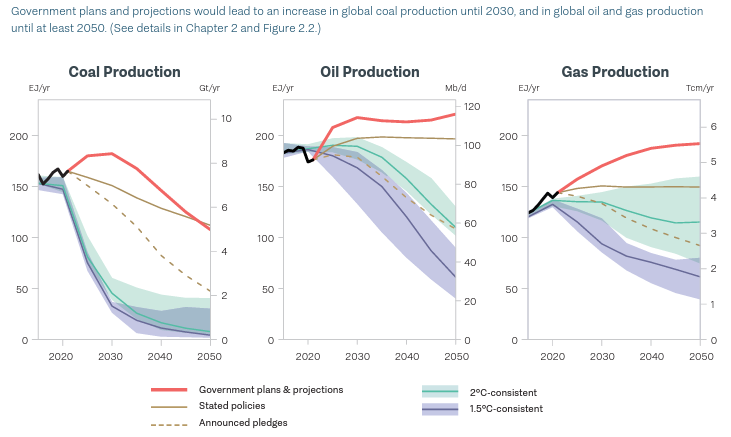
- This projection exceeds the 2°C target by 69%, emphasizing the pressing need for more ambitious climate action.
- Taken together, government plans and projections would lead to an increase in global coal production until 2030, and in global oil and gas production until at least 2050.
- This conflicts with government commitments under the Paris Agreement, and clashes with expectations that global demand for coal, oil, and gas will peak within this decade even without new policies.
- Major producer countries have pledged to achieve net-zero emissions and launched initiatives to reduce emissions from fossil fuel production, but none have committed to reduce coal, oil, and gas production in line with limiting warming to 1.5°C.
- India Specific Findings:
- India’s Updated NDCs:
- Emission Reduction: India's NDC aims to cut emissions intensity by 45% compared to 2005 levels by 2030.
- Renewable Energy Share: It targets 50% non-fossil power capacity by 2030.
- Long-term Vision: The updated NDC is a stride toward the 2070 net-zero emissions goal.
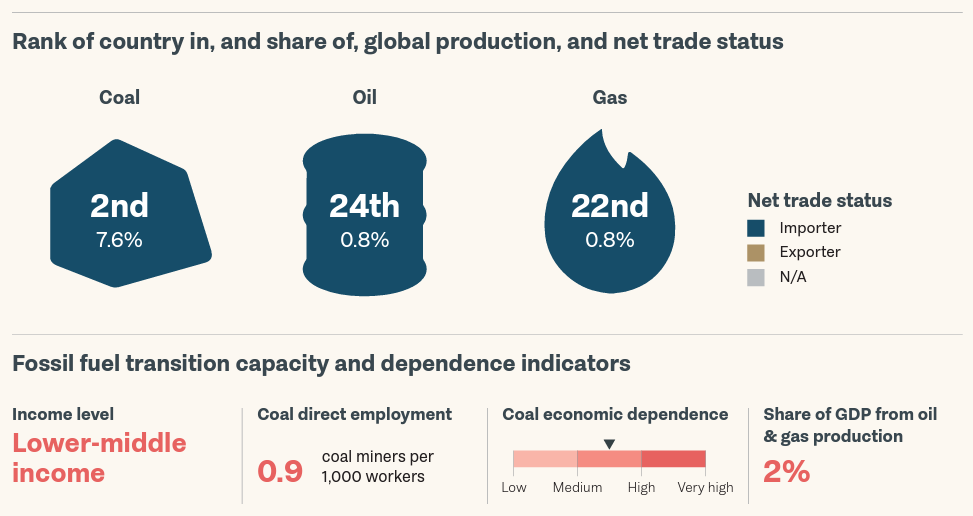
- Government's Stance on Fossil Fuel Production:
- Low-Carbon Transition with National Scale: The Long Term-Low Emission Development Strategy(LT-LEDS) released during COP27 commits to a low-carbon shift that preserves development needs.
- Emphasis is placed on maintaining energy security, access, and employment.
- Support for Domestic Fossil Fuel: An emphasis on self-reliance calls for the expansion of coal production to generate state income and job opportunities.
- Plans include scaling up domestic oil and gas exploration to meet increasing demand as the country's demand for gas is expected to rise by over 500% by 2030.
- The government has set up rolling electronic auctions of mining blocks to increase domestic coal production and is encouraging foreign direct investment in the oil and gas secto.r
- While investing in green energy, India maintains its commitment to fossil fuels, primarily coal.
- ONGC Videsh Ltd (OVL), a subsidiary of India’s national oil company, has stakes in 33 oil and gas projects in 15 countries (ONGC Videsh, 2023).
- Low-Carbon Transition with National Scale: The Long Term-Low Emission Development Strategy(LT-LEDS) released during COP27 commits to a low-carbon shift that preserves development needs.
- Government's Stance on Fossil Fuel Production:
- India’s Updated NDCs:
What are the Recommendations?
- Transparency in Plans: Governments should be more transparent in their plans, projections, and support for fossil fuel production and how they align with national and international climate goals.
- Adopt Fossil Fuels Reduction Targets: There is a strong need for governments to adopt near- and long-term reduction targets in fossil fuel production and use to complement other climate mitigation targets and to reduce the risks of stranded assets.
- Phase out of Fossil fuels: Countries should aim for a near total phase-out of coal production and use by 2040 and a combined reduction in oil and gas production and use by three-quarters by 2050 from 2020 levels, at a minimum.
- An equitable transition away from fossil fuel production must recognize countries’ differentiated responsibilities and capabilities. Governments with greater transition capacity should aim for more ambitious reductions and help finance the transition processes in countries with limited capacities.
Social Issues
Issue of Suicide Cases in Educational Hubs
For Prelims: Issue of Suicide Cases in Educational Hubs, Suicides, Lokniti-Centre for the Study of Developing Societies (CSDS), Depression, Anxiety, and Bipolar Disorder, Manodarpan.
For Mains: Issue of Suicide Cases in Educational Hubs, Salient features of Indian Society.
Why in News?
Recently, the Lokniti-Centre for the Study of Developing Societies (CSDS) has conducted a survey, highlighting a concerning issue of rising student Suicides in Kota.
- The Lokniti-CSDS survey was conducted face-to-face using a structured questionnaire in Hindi, involving over 1,000 students in October 2023. 30 % of the sample consisted of girls.
- A majority of students who study in Kota’s coaching centres come from Bihar, Uttar Pradesh, Rajasthan, and Madhya Pradesh. Nearly half of them belong to cities and small towns; only 14% come from villages.
What are the Reasons for More Students Going to Kota?
- Influence of Family and Relatives:
- A significant number of students have immediate family members or extended relatives who studied in Kota, influencing their decision to come to Kota.
- Social media and recommendations from friends and parents also play a role in their decision.
- Entrance Exam Focus:
- Students in Kota are predominantly preparing for NEET (medical entrance exam) and JEE (engineering entrance exam).
- NEET is more popular among girls, while JEE is favored by boys.
- Students in Kota are predominantly preparing for NEET (medical entrance exam) and JEE (engineering entrance exam).
- Dummy Schools without Regular Attendance:
- Clearing board exams is a prerequisite for entrance exams. The majority of students in Kota are enrolled in 'dummy schools' that do not require regular attendance and only facilitate board exam appearances.
What is the Status of Suicides in India as per NCRB’s ADSI Report 2021?
- Overall Suicides Status:
- According to the National Crime Records Bureau’s (NCRB’s) Accidental Deaths & Suicides in India (ADSI) 2021, a total of 1,64,033 suicides were reported in the country during 2021 showing an increase of 7.2% in comparison to 2020.
- Rate of Suicides in India was 12.0% in 2021.
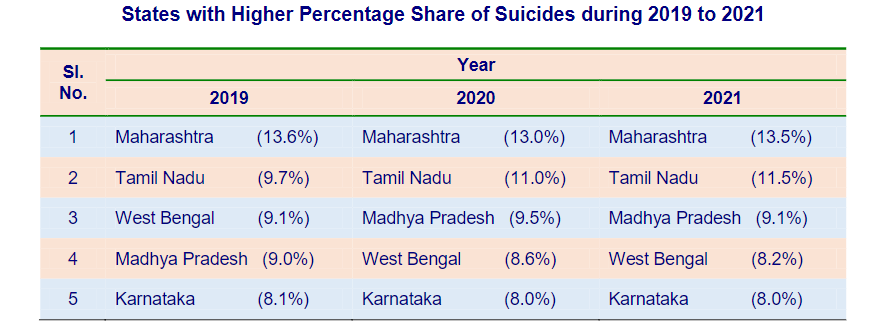
- Suicides Status in Students:
- Over 13,000 students died by in 2021 in India at the rate of more than 35 every day, a rise of 4.5% from the 12,526 deaths in 2020 with 864 out of 10,732 suicides being due to failure in examination.
- The report also showed the percentage of women student suicide was at a five-year low of 43.49% in 2021, while men student suicides made up 56.51% of the total student suicides.
- In 2017, 4,711 women students died by suicide, while in 2021 such deaths increased to 5,693.
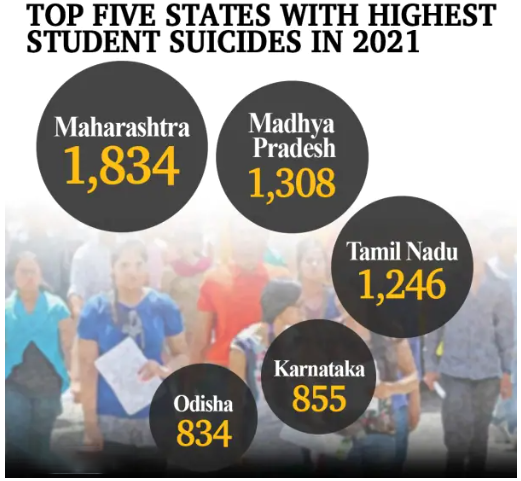
What are the Reasons for Increasing Suicide Cases in Educational Hub?
- Academic Pressure:
- High expectations from parents, teachers and society can lead to excessive stress and pressure to perform well in exams.
- This pressure to succeed can be overwhelming for some students, leading to feelings of failure and hopelessness.
- Mental Health Issues:
- Mental health problems such as depression, anxiety, and bipolar disorder can contribute to student suicides.
- These conditions can be exacerbated by stress, loneliness, and lack of support.
- Mental health problems such as depression, anxiety, and bipolar disorder can contribute to student suicides.
- Isolation and Loneliness:
- Many students in educational hubs come from far away and live away from their families and friends.
- This can lead to feelings of isolation and loneliness, which can be particularly difficult to deal with in an unfamiliar and competitive environment.
- Financial Concerns:
- Financial difficulties, such as not being able to afford tuition fees or living expenses, can create a great deal of stress and worry for students.
- This can lead to feelings of hopelessness and desperation.
- Lack of Support:
- Many students in educational hubs are reluctant to reach out for help when they are struggling.
- This can be due to stigma surrounding mental health problems or a fear of being judged.
- This lack of support can lead to feelings of hopelessness and desperation.
- Stigma Surrounding Failure:
- In Indian society, failure in competitive exams is often stigmatized. Students may feel ashamed to admit their struggles or discuss their mental health issues, leading to a lack of support and understanding.
What are the Initiatives To Curb Suicides?
- Global Initiatives:
- World Suicide Prevention Day (WSPD): Observed on 10th of September every year, WSPD was established in 2003 by the International Association for Suicide Prevention (IASP) in conjunction with the WHO. It focuses attention on the issue, reduces stigma and raises awareness among organizations, government, and the public, giving a singular message that suicide can be prevented.
- World Mental Health Day: 10th October is celebrated as World Mental Health Day, every year. The overall objective of World Mental Health Day is to raise awareness of mental health issues around the world and to mobilize efforts in support of mental health.
- Indian Initiatives:
- Mental Healthcare Act (MHA), 2017: MHA 2017 aims to provide mental healthcare services for persons with mental illness.
- KIRAN: The Ministry of Social Justice and Empowerment has launched a 24/7 toll-free helpline “KIRAN” to provide support to people facing anxiety, stress, depression, suicidal thoughts and other mental health concerns.
- Manodarpan Initiative: Manodarpan is an initiative of the Ministry of Education under Atmanirbhar Bharat Abhiyan.
- It is aimed to provide psychosocial support to students, family members and teachers for their mental health and well-being during the times of Covid-19.
- National Suicide Prevention Strategy: Announced in 2023, National Suicide Prevention Strategy is the first of its kind in the country, with time-bound action plans and multi-sectoral collaborations to achieve reduction in suicide mortality by 10% by 2030. The strategy is in line with the World Health Organisation’s South East-Asia Region Strategy for suicide prevention.
Way Forward
- Providing students with access to mental health services and resources such as counseling services, support groups, and psychiatric services can help prevent suicides. Also, schools and universities must train teachers, staff, and students in mental health first aid .
- Positive attitudes towards mental health and help-seeking must also be promoted through open discussions about mental health and suicide.
- Socio-economic factors such as poverty, homelessness, and unemployment should be addressed to improve students' overall well-being and reduce stress, anxiety, and depression.
UPSC Civil Services Examination, Previous Year Question:
Mains
Q. Why suicide among young women is increasing in Indian society? (2023)
Important Facts For Prelims
Global Positioning System Tracker Anklet
Why in News?
Recently, a prisoner in Jammu and Kashmir was released on bail after he was tagged with a Global Positioning System (GPS) tracker anklet on his foot to monitor his movements.
- This is the first time in the country that a GPS tracker has been put to such use.
What are GPS Tracker Anklets?
- About:
- GPS anklets are small, wearable devices that are attached to the ankles of individuals who are under some form of legal supervision, such as parole, probation, house arrest, or bail.
- The tracker can be put on the ankle or arm of a person. Thus, there are GPS anklets and GPS bracelets.
- GPS anklets are tamper-proof, and any attempt to remove or damage them triggers an alarm.
- They also have a battery life of several days and can be recharged by the wearer.
- GPS anklets can also be used to enforce curfews, travel restrictions, or other conditions imposed by the court or the supervising agency.
- GPS anklets are small, wearable devices that are attached to the ankles of individuals who are under some form of legal supervision, such as parole, probation, house arrest, or bail.
- Working Procedure:
- GPS anklets use the GPS technology to provide the exact location of the wearer at all times, and allow law enforcement and security agencies to monitor their movements in real-time.
- GPS Anklets usage on Prisoners:
- GPS anklets alleviate criminal justice costs, easing prison overcrowding and directing resources to serious offenses.
- They balance public safety and rehabilitation by deterring crime, ensuring law compliance, and fostering offender well-being through family ties, education, and support services.
- Legal Position on the Use of GPS Anklets Globally:
- GPS trackers are a precondition for bail in several countries including the United States, the United Kingdom, and Malaysia.
- Concerns Regarding the GPS Anklets in India:
- Rights activists argue that tracking individuals with GPS is a violation of their fundamental right to privacy and dignity of the offenders.
- The Supreme Court of India in ‘Maneka Gandhi vs Union of India’ (1978) ruled that the right to life includes the right to human dignity.
- GPS anklets raise some legal and ethical issues, such as the lack of clear and specific laws and regulations governing their usage in India.
- Rights activists argue that tracking individuals with GPS is a violation of their fundamental right to privacy and dignity of the offenders.
What is a Global Positioning System?
- GPS is a satellite navigation system, used to determine the ground position of an object. It is a US-owned utility that provides users with Positioning, Navigation, and Timing (PNT) services.
- It provides service to civilian and military users. The civilian service is freely available to all users on a continuous, worldwide basis. The military service is available to US and allied armed forces as well as approved Government agencies.
Note:
- To meet the PNT services of India, Indian Space Research Organisation (ISRO) has established a regional navigation satellite system called Navigation with Indian Constellation (NavIC).
UPSC Civil Services Examination Previous Year Question (PYQ)
Q. In which of the following areas can GPS technology be used? (2018)
- Mobile phone operations
- Banking operations
- Controlling the power grids
Select the correct answer using the code given below:
(a) 1 only
(b) 2 and 3 only
(c) 1 and 3 only
(d) 1, 2 and 3
Ans: (d)
Important Facts For Prelims
Equal Benefits for Women in Armed Forces
Why in News?
Recently, the Defence Minister of India has approved a proposal for extending the rules for maternity, child care and child adoption leave for women soldiers, sailors and air warriors in the Armed Forces on a par with their officer counterparts.
- The decision reflects the vision for inclusive participation, ensuring that all women in the Armed Forces, regardless of rank, receive equal benefits.
Note:
- So far, there were no women air warriors or sailors in the Indian Air Force or Navy. Both started inducting women in their ranks after the government brought in the Agnipath military recruitment scheme that was introduced in 2022.
- The Army initially inducted women in the Corps of Military Police (CMP) in 2019, and now they are included as Agniveers in the CMP.
What are the Benefits of the New Proposal?
- Only women among the 25% of Agniveers, selected based on merit after a four-year term, qualify for the extended maternity and family-related benefits.
- The Agnipath scheme mandates that these women cannot marry until completing their four-year tenure.
- The new proposal will extend the rules for maternity, child care and child adoption leave for women in the military, whether one is an officer or any other rank.
- Women officers in the armed Forces currently get 180 days of maternity leave, 360 days of child care leave and 180 days of child adoption leave.
- These benefits will now be applicable to women soldiers, sailors and air warriors as well.
- The extension of leave rules will help women in the military to deal with family and social issues relevant to the Armed Forces.
- It will also improve their work conditions and help them balance their professional and family life better.
What is the Agnipath Military Recruitment Scheme?
- About:
- Agnipath, enables patriotic youth to serve in the Armed Forces.
- Participants, termed Agniveers, undergo a 4-year term with around 45,000 to 50,000 recruits annually.
- After four years, only 25% of the batch is selected for a 15-year service extension in their respective services.
- Eligibility Criteria:
- The Agnipath scheme exclusively applies to non-commissioned personnel below officer ranks.
- Commissioned officers hold an exclusive rank in the Indian armed forces. They often hold a commission under the president's sovereign power and are officially instructed to protect the country.
- Eligibility for aspirants is between 17.5 and 23 years.
- The Agnipath scheme exclusively applies to non-commissioned personnel below officer ranks.
- Benefits for Agniveers:
- Upon the completion of the 4-years of service, a one-time ‘Seva Nidhi’ package of Rs 11.71 lakhs will be paid to the Agniveers that will include their accrued interest thereon.
- They will also get a Rs 48 lakh life insurance cover for four years.
- In case of death, the payout will be over Rs 1 crore, including pay for the unserved tenure.
- The government will help rehabilitate soldiers who leave the services after four years. They will be provided with skill certificates and bridge courses.
Important Facts For Prelims
Displacement in Democratic Republic of Congo
Why in News?
The UN International Organization of Migration (IOM) recently reported a surge in internal displacement in the Democratic Republic of Congo (DRC), reaching a staggering 6.9 million.
- In the eastern province of North Kivu, nearly a million people have been displaced due to the ongoing conflict with the rebel group, Mouvement du 23 Mars (M23).
What Factors Contribute to the Widespread Displacement in Congo?
- Conflict in the DRC:
- Originating in the 1990s with civil wars in 1996 and 1998, the DRC conflict was exacerbated by the aftermath of the 1994 Rwandan genocide, where ethnic Hutu extremists killed around one million minority ethnic Tutsis and non-extremist Hutus.
- The eastern DRC, bordering Rwanda, has since faced insurgency from over 120 rebel groups ( as per UN Report), leading to heightened tensions and violence.
- Territorial disputes and resource competition fuel the conflict, resulting in substantial casualties.
- Recent resurgence of the Tutsi-led M23 rebel campaign from November 2021 has further intensified security challenges, with M23 making notable advances since January 2023.
- Major Stakeholders in the Conflict:
- Noteworthy rebel groups, in addition to M23, encompass the Allied Democratic Forces (ADF) and the Cooperative for Development of the Congo (CODECO).
- ADF, an insurgent group based in Uganda since 1999, pledged allegiance to the Islamic State in 2019.
- CODECO asserts its mission to safeguard the interests of the ethnic Lendu against the Hemas and the Congolese army.
- Noteworthy rebel groups, in addition to M23, encompass the Allied Democratic Forces (ADF) and the Cooperative for Development of the Congo (CODECO).
- Causes of Displacement:
- Ethnic Intolerance and Insurgency: Post-Rwandan genocide, two million Hutu refugees migrated to North and South Kivu, sparking ethnic militias and escalating tensions.
- Political Uncertainty and Governance Issues: The current President of DRC faces election challenges amid ongoing insecurity, risking the integrity of a "free, democratic, and transparent" vote.
- Regional Tensions: Armed groups, backed by Rwanda, Uganda, and Burundi, act as proxies, heightening conflict dynamics and regional instability.
- Humanitarian Crisis: Kivu Security Tractor reports 1,400 fatalities and 600+ attacks in 2023.
- Over 1.1 million people in North Kivu, Ituri, and South Kivu need food support, as international response, particularly in funding, remains insufficient.
What are the Major Facts Related to DRC?
- Geography
- The DRC is the second largest country in Africa and the 11th largest in the world.
- It has 37 kilometers of coastline and more than half of the country is covered by dense tropical rainforest.
- Capital:
- Kinshasa is the capital of the DRC and is located on the Congo River.
- Bordering Countries:
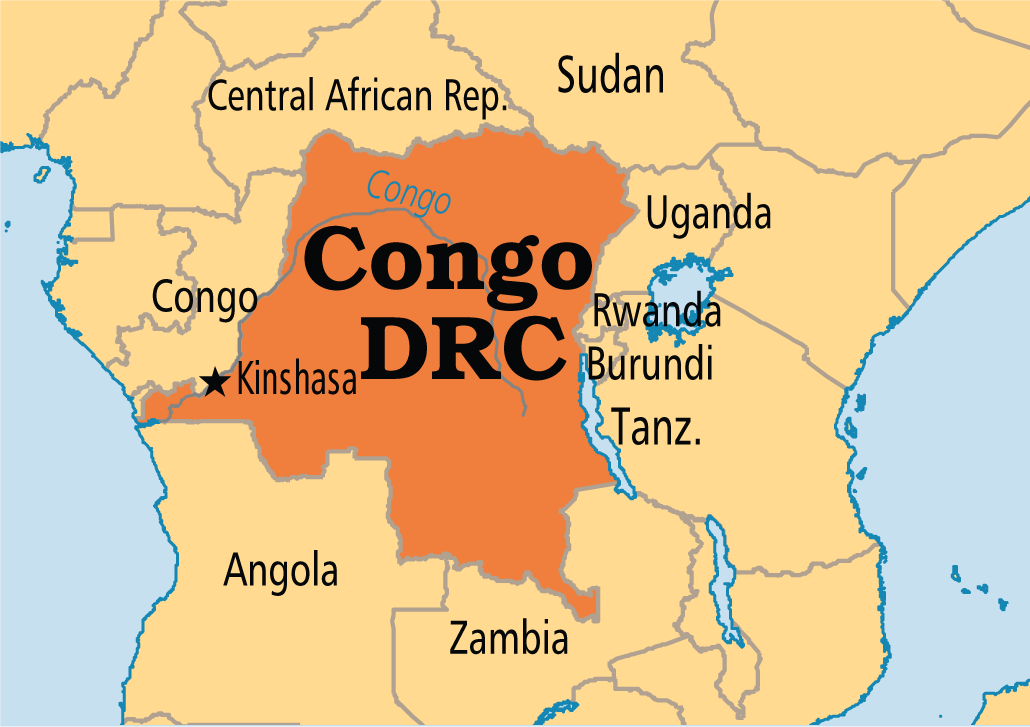
- Languages:
- The official language is French, but other languages include Kituba, Lingala, Swahili, and Tshiluba.
- Currency:
- Congolese franc (CDF).
- Natural Resources:
- It is rich in natural resources. This includes timber, oil and gas, gold and diamonds, as well as minerals critical to the energy transition, like cobalt and copper.
- Major Species:
- Great apes such as bonobos and eastern lowland gorillas can only be found in Congo.
UPSC Civil Services Examination, Previous Year Question (PYQ)
Q.1 Consider the following pairs: (2022)
Country Important reason for being in the news recently
- Chad – Setting up of permanent military base by China
- Guinea – Suspension of Constitution and Government by military
- Lebanon – Severe and prolonged economic depression
- Tunisia – Suspension of Parliament by President
How many pairs given above are correctly, matched?
(a) Only one pair (b) Only two pairs
(c) Only three pairs (d) All four pairs
Ans: (c)
Q.2 About three-fourths of world's cobalt, a metal required for the manufacture of batteries for electric motor vehicles, is produced by (2023)
(a) Argentina
(b) Botswana
(c) the Democratic Republic of the Congo
(d) Kazakhstan
Ans: (c)
Exp:
The Democratic Republic of Congo (DRC) is by far the world's largest producer of cobalt, accounting for roughly 70 percent of global production. Hence, option (c) is correct.
Q.3 Which one of the following is a part of the Congo Basin? (2023)
(a) Cameroon
(b) Nigeria
(c) South Sudan
(d) Uganda
Ans: (a)
Exp:
The Congo Basin spans across six countries—Cameroon, Central African Republic, Democratic Republic of the Congo, Republic of the Congo, Equatorial Guinea and Gabon. Hence, option (a) is correct.
Rapid Fire
Rapid Fire Current Affairs
Birth Anniversary of Birsa Munda
The Prime Minister of India paid tributes to tribal leader Birsa Munda on his birth anniversary(15th November 1875) belonging to the Munda tribe in the Chotanagpur Plateau area.
- In response to the British colonial presence and missionaries' attempts to convert tribals to Christianity, Birsa Munda initiated the 'Birsait' faith, emerging as a tribal leader and leading resistance against British conversion efforts.
- He led the Munda Rebellion aimed to establish Munda Raj, or self-rule, and restore the tribal rights over their land and forest.
- Birsa Munda encouraged tribals to resist colonial laws and refuse to pay rent. He started the Ulgulan movement involving guerrilla warfare, challenging religious practices, and social changes.
- The Ulgulan movement aimed at establishing Munda Raj by driving out the British.
- Birth anniversary celebrated as Janjatiya Gaurav Divas, acknowledging tribal contributions.
- He is Remembered as 'Bhagwan' (God) and 'Dharati Aba' (Father of the earth) by followers.
- Jharkhand, meaning "The Land of Forests," was formed on November 15, 2000, marking the birth anniversary of Bhagwan Birsa Munda.
Read more: Birth Anniversary of Birsa Munda, Janjatiya Gaurav Divas
Bestu Varsh 2023
The Prime Minister of India has extended New Year greetings on the occasion of Gujarati New Year.
- Gujarati New Year 2023, also known as Padwa or Bestu Varas, is being celebrated on November 14.
- It is celebrated as part of the five-day Diwali Celebrations. It ideally falls on Pratipada of Shukla Paksha in the Kartik month (Hindu calendar month).
Read more: India's Traditional New Year Festivals
The Contagious Mystery of Yawning
Yawning, often associated with boredom or a mental break, remains a phenomenon with intriguing contagious qualities.
- In a relatable twist, scientists find that monkeys, much like humans, engage in contagious yawning, especially within similar age and social groups.
- This phenomenon is linked to synchronized sleep-wake patterns and shared attention among primates.
- While not obligatory, yawning serves as a powerful trigger in group dynamics. The study suggests a broader concept of behavioral synchrony, where observed actions influence others in a contagious manner.

